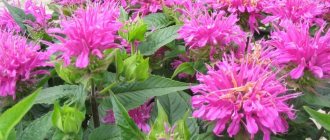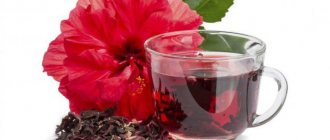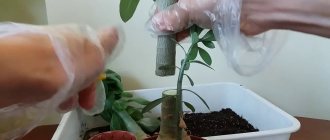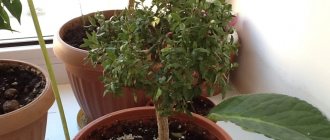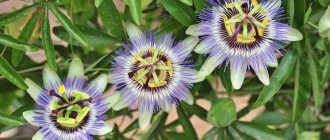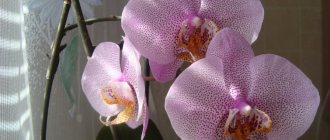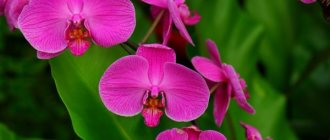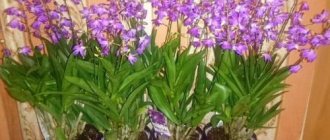How it appeared, where it usually grows
This orchid is a hybrid and belongs to the Phalaenopsis family. Brought out by breeders. It got its name because of its ability to produce many flowers at the same time. Like all representatives of orchids, it belongs to the ancient orchids family, whose homeland is southeast Asia and Australia. For habitat it chooses tree trunks, rocks, shady gorges and mountain forests.
This is interesting: breeding work lasted more than a century, and now each of us can enjoy this flower at home. There is no longer any need to fear that the conditions will not be right and he will die.
Differences from other types of orchids
Multiflora belongs to the average phalaenopsis . It often grows 5-6 rich green leaves. A distinctive feature of multiflora is the withering of old leaf blades during the beginning of the growth of young leaves.
Another characteristic feature is the absence of a growth point. This indicates that the leaves are coming straight out of the soil. Flower arrows are also not simple - they have the ability to branch during flowering, forming many shoots with buds.
Names of varieties, photos
They come in a wide variety of colors and how the shades are combined. The most popular are phalaenopsis plants with delicate or bright, contrasting buds. It’s easy to see their beauty by looking at the photo.
Multiflora white (Phalaenopsis Multiflora white)
The flowers are small, pure white, the petals are uniform. The middle is soft yellow.
Multiflora purple (Phalaenopsis Multiflora purple)
As you can easily guess from the name, this specimen is lilac in color, slightly lighter in the center. The buds sparkle in the light.
Phalaenopsis Multiflora Sannion
An interesting orchid reminiscent of Phalaenopsis Wildcat. The predatory coloring is similar to the skin of a leopard. The specks are small, pink-violet, the middle is lilac, uniform. The petals are usually white, but due to the pattern they may appear purple from a distance.
Santos
This subspecies is close in color to Phalaenopsis Multiflora white, and is just as delicate. But the buds do not have a very pronounced lavender tint and are more crowded.
Black night
Mesmerizing with its contrast: the purple of the main color emphasizes the milky white middle. Unlike its counterparts, a blooming flower resembles a triangle in shape. There are many other names.
This is interesting: the phalaenopsis orchid easily changes the shade of its roots - from greenish when they are wet to silver when dry.
Bloom
Multiflora is a big fan of decorating itself with buds. They bloom in winter, and especially abundantly in summer. This species is very rarely and does not remain dormant for long. Before flowering, strictly monitor the temperature, do not let it drop below +27 °C. The nighttime difference should not exceed 3-5 degrees. An additional light source is also necessary, since natural light may not be enough.
Then move the pot to a cooler place. This will force the orchid to enter a new period of flowering. After one and a half to two months, return the plant to its old place and reduce watering.
What to do if it doesn't bloom
Stimulate by lowering the daytime temperature to +22 °C. Night temperature should not differ by more than four degrees. Under no circumstances allow the thermometer to drop below +20 °C during the day - in this case, diseases and dropping of buds are possible. You also need to trim the faded stem to the second eye from the bottom.
Caring for the Multiflora orchid at home
This orchid is a hybrid, and it does not need to be created in the same conditions as in a greenhouse or tropical forest. It can be noted that Multiflora will not need any more care than other phalaenopsis.
Place
Correct: bright during the day, with artificial light sources in the evening, warm enough.
The chosen one is incorrect: subject to drafts or dry air (for example, near a battery), in direct sunlight, or, on the contrary, excessively gloomy.
Important: if leaves and petals fall off, move the plant to a brighter place. If the orchid turns yellow, protect it from exposure to bright sun.
Soil and pot
Orchid requires special soil. You can buy it in a store or make it yourself. To do this you will need (in order of filling the container):
- polystyrene foam or construction expanded clay as drainage;
- pine bark, divided into small pieces that must be disinfected with boiling water;
- charcoal;
- sphagnum, also known as peat moss (to cover the substrate and retain moisture).
You will need a container for planting with drainage holes; they should be located along the entire bottom and on the walls of the lower part of the pot. Choose depending on the size of the root system of your orchid. It should be positioned freely, but in such a way that there is no extra empty space left. Give preference to low specimens without narrowing, made of transparent material.
Temperature and humidity
The flower should be warm. In any season, the thermometer cannot drop below +23 °C...+25 °C during the day. Avoid excessively sudden changes in night temperature, optimally no more than 7 degrees.
Humidity is also important for Multiflora. Keep it at 60%. A fluctuation of 10% in both directions is acceptable. If the house is too damp, do not forget about timely ventilation, having first protected your pet from drafts.
Light
This plant is accustomed to good light. In winter, when evening comes quickly, turn on the lamps. In summer, take care to shade the windows with a light cloth so that the orchid does not suffer from too much sun.
Watering
It is carried out with clean water at room temperature, which during the process should only fall on the ground. If leaves are affected, they should be carefully dried with a paper towel to prevent rotting.
Follow the procedure correctly:
- lower the container with the flower into a basin of water, hold for no more than one minute;
- then let it drain and empty the tray of excess moisture.
Advice: it is better to water in the morning, once a week. If the weather is hot, spraying with a spray bottle is acceptable.
Fertilizers
You need to feed Multiflora strictly according to the instructions, it is important not to overdo it. Do this no more than once a week, along with watering, after reading the instructions on the package.
If your plant is in the growing season, fertilize with a mixture of calcium nitrate, urea and magnesium sulfate in a ratio of 2:6:1. If it is winter, reduce the concentration by half.
Transfer
This is done no more often than once every couple of years, when the roots have grown enough and the pot becomes too small for them. Changing the soil to fresh one is also very important for the future life of the plant. In no case should you do this during the flowering period.
Wait until all the buds have dropped; there should be no buds on the stem either. When you remove the orchid from the pot, remove the damaged parts and treat the cuts with ground cinnamon or charcoal. Before placing Multiflora in fresh substrate, make sure that the roots are dry.
Instructions for growing from seeds
Planting orchids from seeds requires patience. This is a rather labor-intensive process, and sometimes it takes up to five years for the first flowers to bloom from the seeds. But it’s worth it and the result will not only make you happy, but also make you proud.
Inventory preparation
To plant orchids, you will need a glass container or bottle with a closing or screw-on lid. Also prepare a sterile syringe or pipette for placing the seeds in the container.
Preparation of a special solution
At home, use Knudson's medium, which is prepared according to a specific recipe:
- Pour 150-200 ml of water (preferably distilled) into agar-agar.
- Once it swells, place it in a water bath until completely dissolved.
- As the agar-agar melts, add the components of Knudson's proto-feed in the order specified in the recipe.
- Do not overexpose agar-agar - this will worsen its properties.
Sterilization of containers
The resulting mixture is poured into containers no more than 2 cm thick, and then sterilized again in a tightly closed state. Do not tilt the containers too much so that liquid does not fall on the walls - this can cause fungus to appear.
Sowing seeds
It is better to carry out sowing over steam, this will ensure sterility in the process. Using a pipette or syringe, transfer the seeds into a container. The process should occur as quickly as possible - the seeds should not have time to become infected with microorganisms from the environment.
Planting sprouts in a pot
The sprouts are planted after a year of being in a glass container.
- By washing, the sprouts are separated from the growing medium.
- Then the water with sprouts is poured into a sterile container and disinfected with the addition of Fundazol.
- Using tweezers, carefully place the sprouts into a previously prepared substrate.
As you can see, this process is more like lab work, but if you get it right, the results will not disappoint.
Reproduction
In nature, phalaenopsis is easily propagated by seeds. It is much more difficult to do this at home, so it is preferable to use air shoots or children.
Process description:
- When there are no buds left on the plant, a cut is made on the dried peduncle 1-1.5 cm above the swelling bud.
- After the baby appears, wait for it to form its own root system no shorter than 5 cm and carefully separate the young plant from the mother one.
- Replant in a small pot with fresh substrate and care as usual.
Orchid babies can be seen in the photographs.
Sub-varieties
This type of orchid has a huge number of subspecies. We will describe only the most popular ones.
Rembrandt
The homeland of this species is Holland. Most often it is purchased by beginning gardeners, since phalaenopsis Rembrant is considered one of the most unpretentious to care for . Despite their small overall size, flowers can reach eight centimeters.
Curvy Tropican
It is distinguished by its ability to adapt. The root system grows very quickly and gets used to new places. The variety is characterized by abundant flowering and a large number of branching peduncles.
Pests and diseases
Most often, Phalaenopsis Multiflora suffers from mites, aphids, snails and slugs, as well as gray rot. Each of them has been well studied and is successfully removed with specially designed insecticides.
Processing process:
- Remove the flower from the pot and rinse it thoroughly in the shower.
- Change the soil to fresh one, because it may contain pest larvae.
- Repeat the treatment several times (taking a week's break) until the threat is completely eliminated.
If the roots have rotted, the buds have begun to fall off and the leaves have turned yellow, it is most likely due to improper care. It is this that is the main cause of orchid diseases. In this case, it is worth carefully reviewing the conditions of keeping the pet.
Important: if the plant is new, it needs a month's quarantine and regular inspections for the presence of insects and diseases. If you have several orchids, and one is sick, you need to isolate it from the rest until complete recovery.
Description of the flower
Multiflora refers mainly to plants with small flowers. One orchid can have many flowers at the same time. The diameter, as a rule, is 2–3 cm, and sometimes reaches up to 6 cm. Each adult plant has dense oval-shaped leaves from 4 to 8 pieces, sometimes up to 12.
The length is about 30 cm. The leaves have a rich green color, neatly collected in a rosette. It is extremely difficult to see the flower bud, since the orchid's arrows grow from the ground right next to the leaves. In their usual form there are 2–3 of them, but sometimes there are up to 6.
Fragile flower stalks need care and support - they grow quickly, branch, and form new stems with buds. The height of an adult flowering orchid reaches about 50 cm, and about 15 flowers bloom one after another on each peduncle.
The color palette of orchids is extremely diverse: white, numerous shades of pink, lilac, orange, coral.
Prevention of various problems
There's nothing complicated about it. As mentioned above, Multiflora is best protected by timely and proper care. Therefore, do not forget to wash off the dust from the plant weekly in the shower. Strengthen it with fertilizers, then your beauty will have enough strength to fight possible diseases. Monitor light, temperature and humidity. Inspect carefully from time to time to spot pests.
Now you know in detail what it is - the Multiflora orchid. Despite her unpretentiousness, she needs your attention and care. However, he will repay generously, because such a beautiful plant still needs to be looked for.
History of origin
Orchid Multiflora - “multi” - from English - many , that is, the orchid has gone through many stages and periods of crossing from the ancestors of the 18th century to today’s hybrid variations.
Everything that can be ordered on Internet sites or in special stores is the achievements of modern specialists. Natural varieties of orchids are under the protection of the state, which is trying to preserve pristine plants in many countries of the world. These types of phalaenopsis do not tolerate the climate of European countries, because their homeland is humid and warm Asia and other tropical areas of the Earth. Therefore, 100 years ago, breeders adapted and “tamed” the eastern beauty to our conditions.
